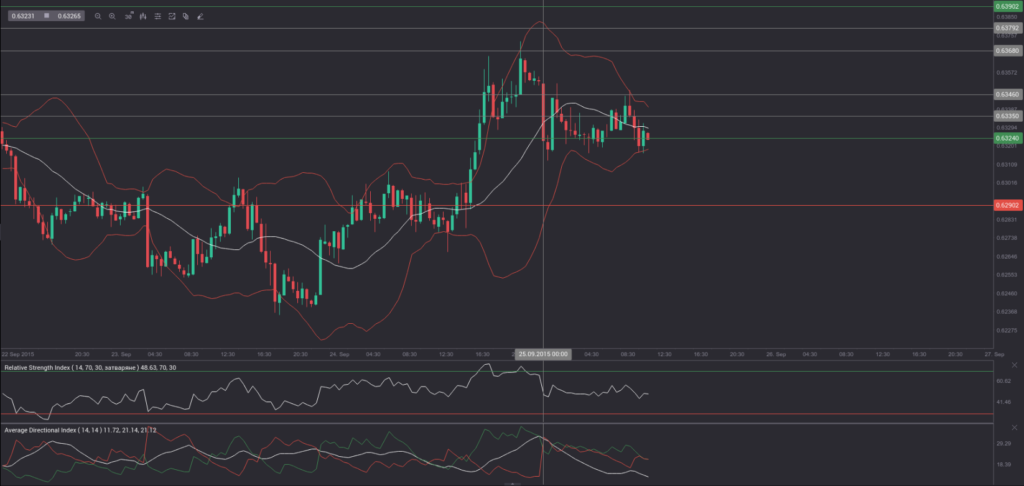 Yesterday’s trade saw NZD/USD within the range of 0.6259-0.6380. The pair closed at 0.6357, soaring 1.32% on a daily basis, or the most considerable daily gain since September 8th, when it appreciated 1.37%. The daily high has been the highest level since September 21st, when the cross registered a high of 0.6405.
Yesterday’s trade saw NZD/USD within the range of 0.6259-0.6380. The pair closed at 0.6357, soaring 1.32% on a daily basis, or the most considerable daily gain since September 8th, when it appreciated 1.37%. The daily high has been the highest level since September 21st, when the cross registered a high of 0.6405.
At 7:30 GMT today NZD/USD was losing 0.28% for the day to trade at 0.6337. The pair tested the range support level (S3), as it touched a daily low at 0.6318 at 8:01 GMT.
NZD/USD was largely influenced by Fed Chair Janet Yellens statement, which she delivered yesterday. She stated that recent global economic fears and financial market turbulence are not expected to have a significant impact on Federal Reserves policy course, stressing that she and most of her colleagues expect to tighten monetary policy this year.
Today the cross may be influenced by a number of macroeconomic reports as listed below.
Fundamentals
United States
Gross Domestic Product – final estimate
The final estimate of the US Gross Domestic Product probably pointed to an annualized rate of growth of 3.7% in the second quarter of 2015. If so, it would confirm the 2nd GDP estimate, reported on August 27th. The 2nd estimate outpaced the preliminary one, because of higher business spending and faster build up of inventories, according to the Bureau of Economic Analysis.
According to the August 27th report, non-residential fixed asset investment expanded 3.2% in Q2. The preliminary estimate pointed to a 0.6% drop. Investment in non-residential structures rose 3.1% in Q2, while the preliminary estimate pointed to a 1.6% decrease. Equipment investment shrank less than expected, at a pace of 0.4%, compared to a 4.1% drop pointed by the preliminary estimate. The accumulation of inventories in Q2 was revised up to USD 121.1 billion, from the preliminary USD 110.0 billion. This way it contributed 0.22% to growth instead of shedding 0.08% as pointed by the advance estimate. In addition, personal consumption expenditures rose at a faster pace in Q2, 3.1% compared to a preliminary 2.9% increase.
In case the final GDP growth rate exceeded the median forecast by experts, this would cause a strong bullish impact on the greenback. The official data by the Bureau of Economic Analysis are to be released at 12:30 GMT.
Services PMI by Markit – preliminary estimate
Activity in the US sector of services probably slowed down in September, with the corresponding preliminary Purchasing Managers Index coming in at a reading of 55.6. If so, this would be the lowest index reading since June, when the PMI stood at a final 54.8. In August the final seasonally adjusted PMI came in at 56.1, up from a preliminary value of 55.2. The PMI is based on data collected from a representative panel of more than 400 private sector companies, which encompasses industries such as transport and communication, financial intermediaries, business and personal services, computing & IT and hotels and restaurants. Values above the key level of 50.0 indicate optimism (expanding activity). In case, however, a larger-than-projected slowdown in services sector activity was reported, this would have a moderate bearish effect on the US dollar. The preliminary data by Markit Economics is due out at 13:45 GMT.
Reuters/Michigan Consumer Sentiment Index – final estimate
The monthly survey by Thomson Reuters and the University of Michigan may show that consumer confidence in the United States lowered for a third consecutive month in September. The final reading of the corresponding index, which usually comes out two weeks after the preliminary data, probably came in at 86.9, up from a preliminary value of 85.7. If market expectations were met, this would be the lowest level since October 2014, when the gauge of sentiment was reported at a final 86.9. In August the gauge of confidence came in at a final reading of 91.9, down from a preliminary value of 92.9. The survey encompasses about 500 respondents throughout the country. The index is comprised by two major components, a gauge of current conditions and a gauge of expectations. The current conditions index is based on the answers to two standard questions, while the index of expectations is based on three standard questions. All five questions have an equal weight in determining the value of the overall index.
According to preliminary data, the sub-index of current economic conditions, which measures US consumers’ views of their personal finances, decreased to a reading of 100.3 in September from a final 105.1 in August. The sub-index of consumer expectations plunged to a flash reading of 76.4 in September, down from a final value of 83.4 in August. According to survey results, American citizens expect that the inflation rate will reach 2.9% in 2016, up from a rate of 2.8%, as pointed in the August survey.
In case the gauge of consumer sentiment showed a larger decrease than anticipated, this would have a moderate bearish effect on the dollar. The final reading is due out at 14:00 GMT.
Bond Yield Spread
The yield on New Zealand’s 2-year government bonds went as high as 2.495% on September 24th, or the highest level since September 17th (2.510%), after which it closed at 2.480% to add 5.5 basis points (0.055 percentage point) on a daily basis.
The yield on US 2-year government bonds climbed as high as 0.715% on September 24th, or the highest level since September 22nd (0.719%), after which it fell to 0.621% at the close to lose 8.2 basis points (0.082 percentage point) for the day.
The spread between 2-year New Zealand and 2-year US bond yields, which reflects the flow of funds in a short term, widened to 1.859% on September 24th from 1.722% during the prior day. The September 24th yield spread has been the largest one since September 3rd, when the difference was 1.869%.
Meanwhile, the yield on New Zealand’s 10-year government bonds soared as high as 3.335% on September 24th, after which it closed at 3.310% to lose 3.5 basis points (0.035 percentage point) compared to September 23rd.
The yield on US 10-year government bonds climbed as high as 2.166% on September 24th, after which it slipped to 2.150% at the close to lose 0.001 percentage point on a daily basis.
The spread between 10-year New Zealand and 10-year US bond yields widened to 1.160% on September 24th from 1.124% during the prior day. The September 24th yield difference has been the largest one since September 22nd, when the spread was 1.213%.
Daily and Weekly Pivot Levels
By employing the Camarilla calculation method, the daily pivot levels for NZD/USD are presented as follows:
R1 – 0.6368
R2 – 0.6379
R3 (range resistance) – 0.6390
R4 (range breakout) – 0.6424
S1 – 0.6346
S2 – 0.6335
S3 (range support) – 0.6324
S4 (range breakout) – 0.6290
By using the traditional method of calculation, the weekly pivot levels for NZD/USD are presented as follows:
Central Pivot Point – 0.6382
R1 – 0.6474
R2 – 0.6550
R3 – 0.6642
S1 – 0.6306
S2 – 0.6214
S3 – 0.6138






